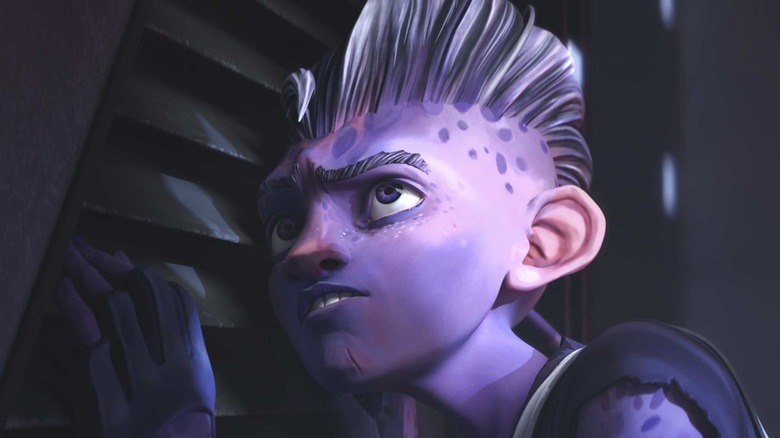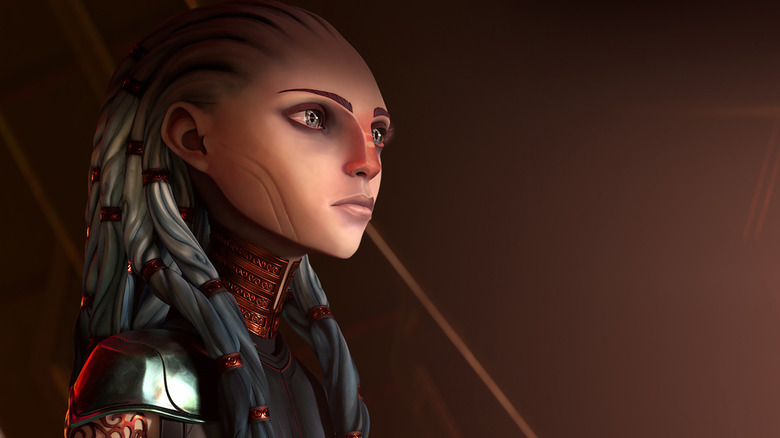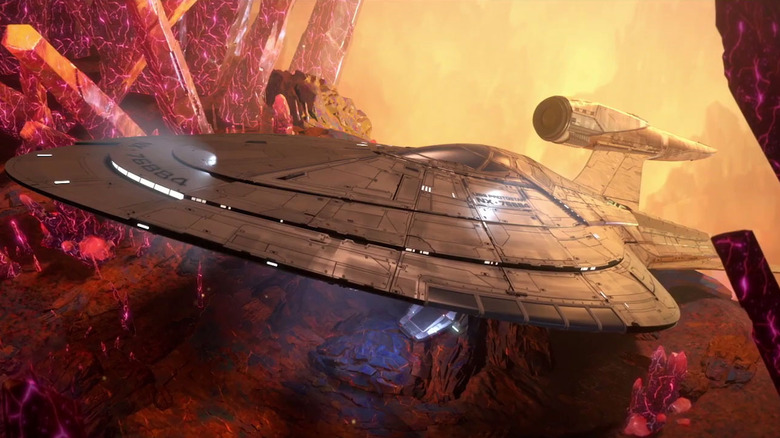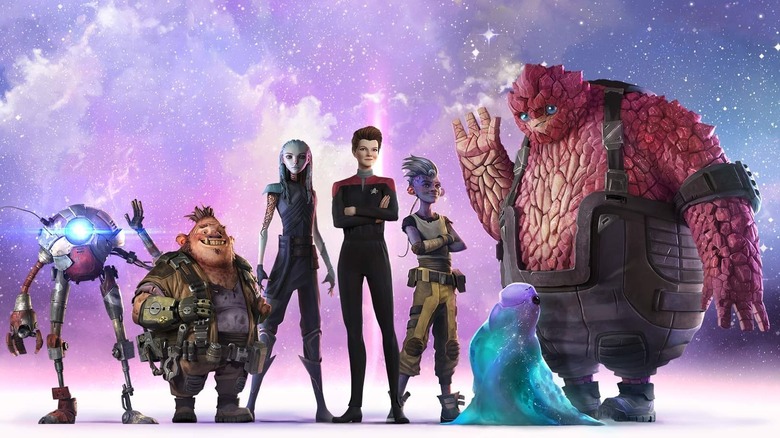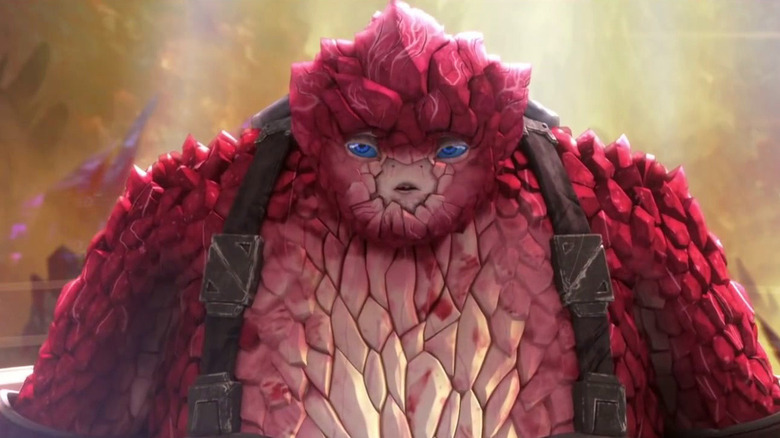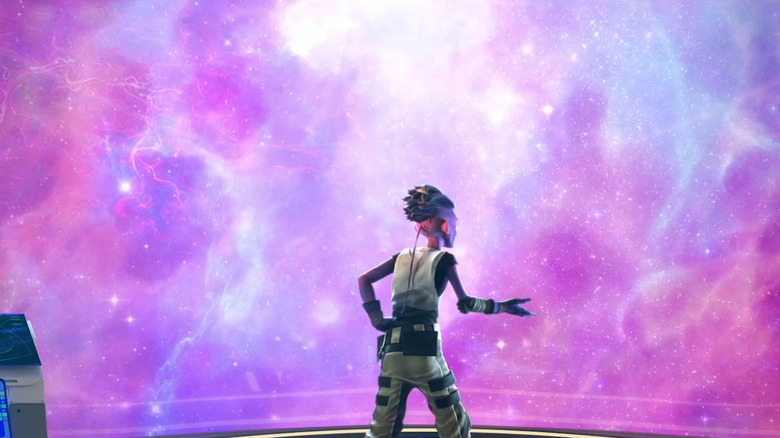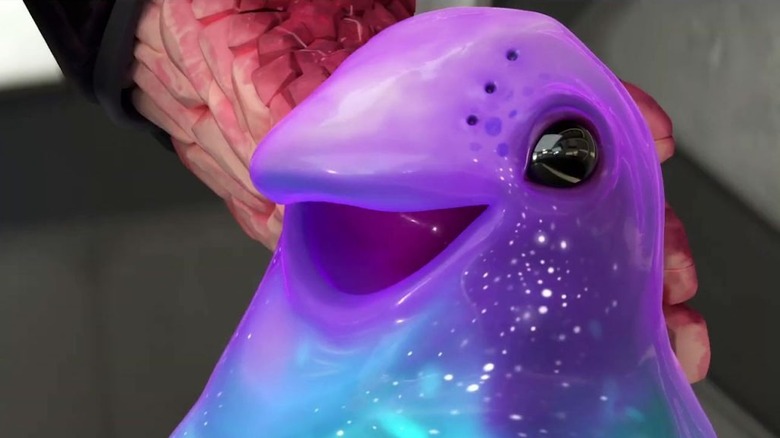Star Trek: Prodigy Season 1A Ending Explained: A Galaxy Far, Far Away
"Star Trek: Prodigy" launched on Paramount+ on October 28, 2021 with a first season that will run 20 episodes. The first 10 episodes of the series, dubbed season 1a, have arrived, with the rest airing later this year. So let's do what all "Star Trek" fans do with our free time and talk at length about it.
"Prodigy" is, if you count "Short Treks" to be a series unto itself, the eleventh Trek series, and the third animated Trek series. "Prodigy" also aimed to be more kid-friendly than its predecessors, featuring, as it does, a cast of non-Starfleet teenage characters, and released under Paramount's Nickelodeon banner. The premise is odd for a "Star Trek" series: A group of teens enslaved in a mine escape their captors and chance upon an abandoned Federation starship, the U.S.S. Protostar, which is equipped with a tutorial hologram in the shape of Capt. Kathryn Janeway, played by Kate Mulgrew.
For the bulk of the season, it wasn't made clear when or where "Prodigy" takes place in the broader scope of "Star Trek" (chronology and continuity are typically important to good Trekkies), and for much of the story only Janeway and the Protostar itself (computer voiced by Bonnie Gordon), there were little indicators of anything else traditionally Trek-related. It wouldn't be until episode nine that the central cast would even put on uniforms. One of the characters, Zero (Angus Imrie) is a Medusan, a species last seen in the original series episode "In There in Truth No Beauty?," and another, Jankom Pog (Jason Mantzoukas), is a Tellarite, a species seen here and there throughout Trek. Otherwise, "Prodigy" seeks to begin its own, fresh mythology, exploring the "Star Trek" galaxy in the places where Starfleet doesn't exist.
That galaxy, we have found out, is very similar to "Star Wars."
A long time ago in a galaxy far, etc.
Even after only a brief glimpse, one might find the characters on "Prodigy" bear direct analogues to character in "Star Wars." There is an Evil Emperor in the form of The Diviner (John Noble) who has been searching for the Protostar for mysterious, nefarious reasons revealed in episodes nine and ten. He has his own Darth Vader in the form of Drednok (Jimmi Simpson), an evil robot enforcer hunting down the central cadre of kids. The Diviner's daughter, Gwyn (Ella Purnell), is part of the central cast and bears a more-than-passing resemblance to the "Star Wars" character Ahsoka Tano. She also possesses a signature weapon, a la a Jedi, in the form of a shapeshifting tendril she extends from her arm. A character — as opposed to a whole species — having a signature weapon is most certainly a "Star Wars" concept more than a Trek one. Also floating over Gwyn is a whiff of destiny, as The Diviner makes multiple cryptic comments as to how she was secretly being trained to command the Protostar.
Other comparisons to "Star Wars" can be made, although they may be a bit tenuous. Jankom Pog's vague resemblance to Dexter Jettster is probably just a coincidence, as is the presences of a cute, squeaky sidekick (R2D2 in Wars, Murf in "Prodigy") and a large, gentle bruiser (Chewbacca in Wars, Rok-Tahk in "Prodigy"). Also, "Prodigy's" bent toward action and chases is indicative of Trek's gradual tonal shift toward violence and catastrophe in the Paramount+ era, and not necessarily a conscious need to emulate "Star Wars."
The secret of the Protostar
The first five episodes of "Prodigy" followed our main cast as they escaped from their mining colony, found the Protostar, escaped into the galaxy, and got to know one another, forming a tentative crew under the watchful eye of the Capt. Janeway instructional hologram. After a dalliance on a living planet that presented the crew with tantalizing illusions (but that secretly wanted to drain their minds of emotional energy; par for the course on "Star Trek"), The Diviner had tracked them down, and a climactic moment in episode five ended with a big chase away from The Diviner's Star Destroyer. But the Protostar got away using its rare, unique engine.
In the fourth and fifth episodes of "Prodigy," audiences were given hints that the Protostar — a very small ship, as Federation starships go — is housing a mysterious power source in its drive section. During the above mentioned chase away from The Diviner, Zero points out that the ship is not only named the Protostar, but actually houses a protostar. The process on how a star is born is long and complex, but, in brief, a protostar is when enough molecular clouds, like Bok globules, have accumulated under gravitational forces to form its own dense core. It's a baby star. The U.S.S. Protostar has somehow captured such a star and tapped into its energy as a fuel source, making for a much more powerful engine. Gwyn activates the protostar engine, the ship's drive section opens up and we witness the "Star Trek" version of a NOS blast from a "Fast & Furious" movie. The Protostar zips off the star charts at a speed hitherto unseen.
Cutting down trekking time
In traditional "Star Trek," engines are powered very similarly to internal combustion engines, but instead of burning fuel, they feed off of matter/antimatter explosions. We have seen other engine designs here and there — Romulan ships power their engines with an artificial gravity well — but Starfleet vessels have all operated on a similar principle since the beginning. A protostar engine is a new wrinkle in Trek.
It's also implied that this is the first ship in Trek to have such an engine, as the U.S.S. Protostar has an NX designation. Most ships on Trek have an "NCC" before their call number, while prototype ships are given an NX (the Enterprise in "Enterprise," for example, is NX-01. The U.S.S. Excelsior, first seen in "Star Trek III: The Search for Spock" was NX-2000). Look at the picture above, and you'll see NX-76884 on the Protostar. It's presumably a one-of-a-kind prototype, making the ship rare. And coveted.
A curious new trend in Paramount+ era "Star Trek" is the de-emphasis of, well, trekking. One of the central conceits of "Star Trek: Discovery" is that the ship has an unusual spore-based engine drive that allows them to essentially teleport anywhere in the galaxy. Such a technology would represent a coup for the entire galaxy, so the show has to go out of its way to explain why it isn't instantly made more widely available, or deal with the greater ramifications of erasing all need for travel from the universe. "Picard" is more about androids and dumb, protracted mysteries than it is about exploration and trekking. "Prodigy" has now introduced an engine that can go far, far faster than any ship that came before (that would explain why it was in a remote part of the galaxy that wasn't cognizant of the Federation; it likely sped off during a trial run and landed in a place beyond detection).
When it takes place
With such an engine the crew of the Protostar can explore, yes, but now it seems like the show's writers are trying to get to their destinations faster ... like they do in "Star Wars." In "The Empire Strikes Back," Luke Skywalker takes his light battle craft and flies it to a distant planet. Can his ship travel faster than light? A small craft with tiny engines? How long was his trip? Hours? Days? A month? We don't explore these questions in "Star Wars," because the technology of the craft is less important than getting to the next location. "Trek," in contrast, has always focused more closely on the technical aspects of its starships, however fantastical they may be. The Protostar can now do what Luke Skywalker's craft does. Get to the destination with little consideration as to how far away it is.
Space is quite big, you'll find, and "Trek" acknowledges that even their fictional engines have severe limitations when facing the vastness of the cosmos. The Protostar is another case of Trek trying to undo that vastness. The galaxy is now smaller and easier to traverse. To get to where you're going, you no longer need to trek.
In the final five episodes, the crew of kids will have to learn to be a crew. With Janeway as their guide, the kids will eventually learn to work as a Starfleet crew, trusting one another's talents, never trying to outdo one another. In an amusing episode, Dal proves that he can indeed beat the notoriously difficult Starfleet test called Kobayashi Maru — well, nearly — provided he has enough chances to re-take the test (the Kobayashi scenes allowed multiple old "Star Trek" faces to appear, including Leonard Nimoy as Spock and Gates McFadden as Beverly Crusher). This will ultimately better prepare him to take his self-appointed job as a Starfleet officer more seriously.
Medusans and insanity
After several "Star Trek"-related trials, the main characters are encouraged to put on Starfleet uniforms and hatch a complex scheme to go confront the Diviner and free the people he has enslaved in a two-part episode called "A Moral Star" — the Diviner will free the children in exchange for the ship. The plan will entail learning two important pieces of information: Why the Diviner wants the Protostar, and when "Prodigy" takes place.
For the former, Gwyn — after giving him the Protostar, but cleverly removing its engine — finally confronts her father. He reveals that he has actually traveled from the future where his species had been ripped apart by a vicious civil war. The civil war, we learn, was sparked by First Contact with the Federation; not everyone on his planet wanted to live in peace. His plan was to go back in time, locate a powerful ship, and lay waste to the Federation before it could get to his homeworld. After some action sequence, The Diviner is confronted by the Protostar crew, and Zero reveals their true form to him. As established in Trek canon, a gaze upon a Medusan's true form can instigate madness; they are simply too complex an entity for the typical humanoid mind.
Sadly, in revealing themselves to the Diviner, Gwyn also managed to catch a glimpse of Zero in the reflection of Dal's eyeball, damaging her mind. For the rest of season one, Gwyne may require some counseling and time in the infirmary.
Now we know when
While it would have been nice to leave the timeframe of "Prodigy" vague — it could have been thousands of years in the future! — the show does eventually establish a definite chronology. Oreviously, it had been established that an older Chakotay (Robert Beltran) from "Star Trek: Voyager" was captain of the Protostar, and it was he who was present for the event that left the ship stranded in a distant part of the galaxy. Fine and good, but still no solid time frame.
But then, in a dramatic reveal, Janeway — the real Janeway — is seen answering a distress call. Adm. Janeway has been looking for the Protostar since its disappearance, and, given her age on "Prodigy," hasn't been at it for anything more than a decade. This puts "Prodigy" squarely in the year 2383, concurrent with the events of "Star Trek: Lower Decks," and prior to the events of the second season of "Star Trek: Picard." Given the nature of the show, it may be unlikely that the "Prodigy" characters will interact with any of the other "Star Trek" shows, but we now know that it's possible.
Given that the show is about young people learning to be better officers on their own, it seems more appropriate that they should remain isolated.
Season 1b will air on Paramount+ later this year.
